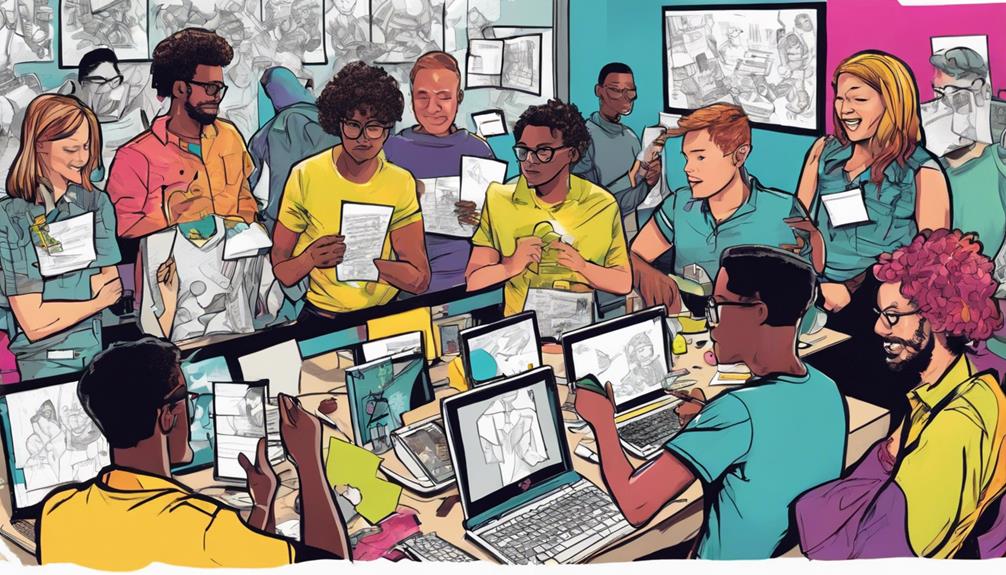Design Thinking for Social Impact is transforming the world through human-centered problem-solving. By understanding user needs, brainstorming creative solutions, and testing prototypes, it tackles complex societal issues innovatively. Its focus on actionable solutions and real-world challenges fosters collaboration and drives positive change. With benefits like enhancing user experience and tailoring solutions for complex issues, Design Thinking is paving the way for impactful social solutions. By fostering creativity, collaboration, and iterative problem-solving, it empowers communities and transforms initiatives. This innovative approach to social impact is reshaping the world for the better.
Key Takeaways
- Human-centered solutions address real-world challenges effectively.
- Foster collaboration for innovative societal solutions.
- Drive positive social impact through actionable solutions.
- Tailored designs for complex issues empower communities.
- Multidisciplinary teams foster creative innovation for lasting change.
Overview of Design Thinking
Design thinking is a human-centered problem-solving approach that involves understanding user needs, brainstorming creative solutions, and prototyping ideas. In the domain of social impact, this process is essential for creating innovative solutions to complex societal challenges.
The design thinking process typically consists of five key steps:
Empathize with users,
Define the problem,
Ideate potential solutions,
Prototype designs, and
Test solutions for iterative learning and improvement.
Through its user-centric approach and emphasis on collaboration and innovation, design thinking enables organizations to develop solutions that address social issues effectively. By continuously testing and refining ideas, design thinking allows for the creation of more impactful solutions that can drive positive change in areas like homelessness, poverty, and healthcare.
The iterative nature of the process ensures that solutions aren't only innovative but also tailored to meet the specific needs of the communities they aim to serve. Design thinking is a powerful tool in the arsenal of social impact organizations endeavoring to make a difference in the world.
Creating Social Impact
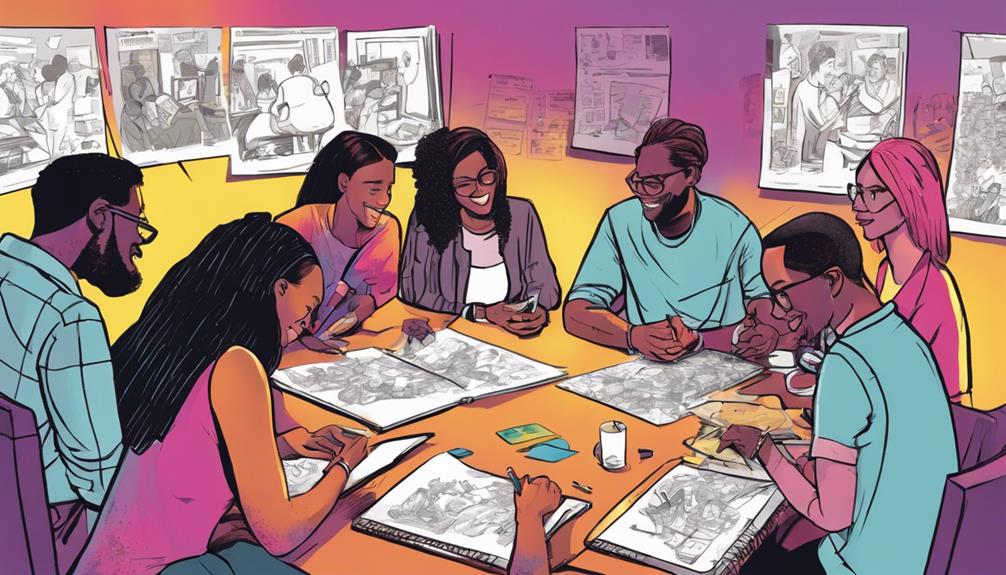
To make a tangible difference in society, it's crucial to focus on creating social impact through actionable solutions that address real-world challenges. Design Thinking provides a human-centered approach to tackling social challenges by understanding the needs of the target population. By fostering the brainstorming of innovative solutions, Design Thinking enables the creation of interventions that can be tested and iterated upon for maximum impact.
Through the process of testing and iterating, solutions are refined to ensure their effectiveness in addressing social issues.
Moreover, collaboration and partnerships play a vital role in scaling up successful Design Thinking solutions to achieve broader social impact. By working together, organizations can amplify the reach and effectiveness of these innovative solutions, ultimately leading to significant improvements in the lives of individuals and communities.
Design Thinking, with its focus on creating tangible social impact, drives the development of solutions that genuinely make a difference by addressing real-world problems.
Real-World Examples

Revolutionizing the approach to microfinance, Grameen Bank, founded by Muhammad Yunus, has made a significant impact with its small loan products for the poor. Several other organizations are also leveraging design thinking to create real-world examples of social impact. WaterHealth International utilizes design thinking to provide clean water solutions in developing countries. Design for America collaborates with communities to develop innovative solutions like affordable housing. The LEGO Foundation promotes creativity and learning in children through design thinking initiatives. Hippo Water Roller addresses water scarcity in rural Africa with a human-centered design approach.
| Organization | Impact |
|---|---|
| Grameen Bank | Small loan products for the poor |
| WaterHealth International | Clean water solutions in developing countries |
| Design for America | Innovative solutions for affordable housing |
| The LEGO Foundation | Promoting creativity and learning in children |
| Hippo Water Roller | Addressing water scarcity in rural Africa |
Design Thinking Process
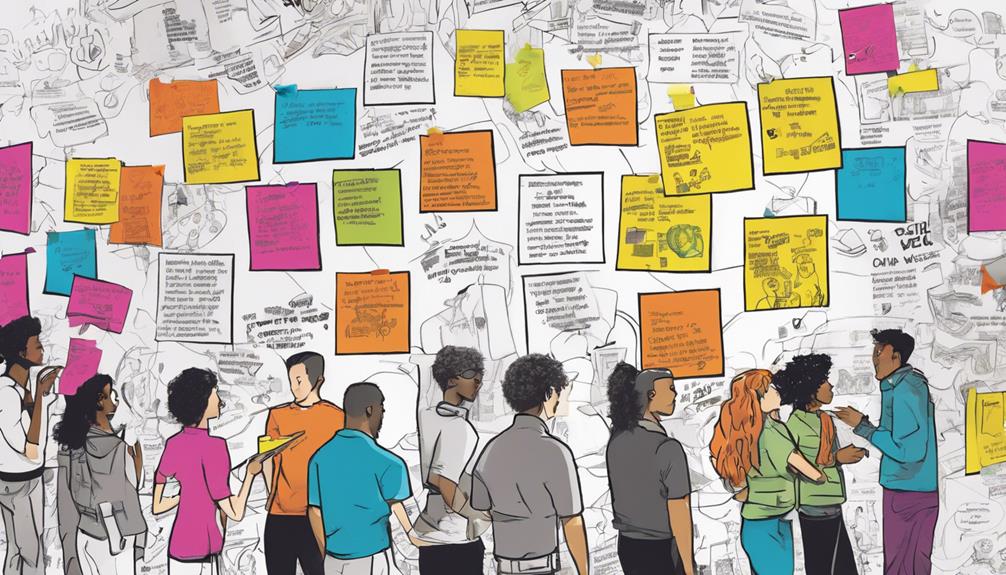
Exploring the complexities of problem understanding, the design thinking process digs deep into user empathy and clear problem definition. Design thinking is a human-centered approach that aims to tackle social issues by first understanding the needs and perspectives of the people affected.
By empathizing with users, designers can gain valuable insights that inform the creation of innovative solutions. Once the problem is clearly defined, the process moves on to ideation, where potential solutions are brainstormed and creatively explored.
Prototyping plays a vital role in the design thinking process, allowing designers to test the feasibility and effectiveness of their ideas. Testing these prototypes with users provides feedback that's essential for refining and improving the solutions.
This iterative approach enables continuous testing, refining, and innovation, ultimately leading to impactful social change. Through its emphasis on empathy and user-centric design, the design thinking process offers a structured framework for addressing complex social challenges.
Benefits and Impact

Enhancing user experience and fostering collaboration, design thinking for social impact brings numerous benefits and impactful outcomes to social initiatives. By employing a human-centered design approach, this innovative problem-solving method drives positive social impact and fosters social innovation.
Through deeply understanding user needs and preferences, design thinking guarantees that solutions are tailored to effectively address complex issues.
One of the key advantages of design thinking is its ability to encourage multidisciplinary teams to work together creatively, leading to the generation of innovative ideas. Additionally, the iterative nature of this approach allows for quick and cost-effective testing of solutions, enabling continuous improvement based on feedback.
Fundamentals of Social Innovation
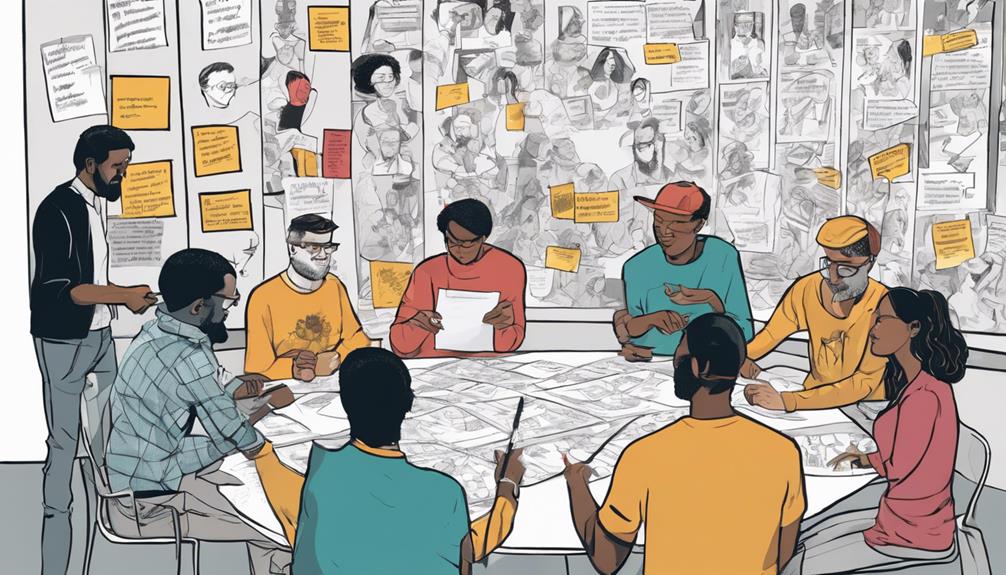
You should understand the Social Innovation Basics to grasp the impact of design on addressing social challenges.
Exploring future trends in innovation will also be essential for your understanding of this topic.
Stay tuned to discover how these fundamentals shape the landscape of design thinking for social impact.
Social Innovation Basics
Understanding the basics of social innovation is vital for creating lasting impact in addressing societal challenges. Here are some key aspects to keep in mind:
- Collective Impact and System Leadership: These are essential components that drive effective social innovation by fostering collaboration and strategic leadership within communities.
- Design Thinking: Using human-centered design approaches can lead to the creation of innovative solutions that cater to the specific needs of the target audience, ensuring positive change.
- Nonprofit Starvation Cycle: Recognizing this cycle underscores the need for fresh and inventive approaches in the field of social entrepreneurship to break free from traditional constraints.
- Ten Nonprofit Funding Models and The Science of What Makes People Care: Understanding these models and the psychology behind motivating individuals to support social causes are vital for successful social innovation initiatives.
Impact of Design
Design thinking plays a pivotal role in shaping the fundamentals of social innovation by emphasizing the impact of design on addressing pressing societal challenges. Through human-centered design, products and services are customized to create positive change and offer solutions to social problems. Design thinking also fosters environmental sustainability by promoting innovative approaches that consider the planet's well-being. Additionally, by engaging with local communities, design thinking guarantees that solutions are culturally relevant and impactful.
To illustrate the impact of design in social innovation, consider the following table:
| Design Impact | Key Aspects |
|---|---|
| Products and Services | Customized to address social problems |
| Human-Centered Design | Focuses on the needs and experiences of people |
| Environmental Sustainability | Promotes eco-friendly solutions |
Future Trends in Innovation
Future trends in social innovation are shaped by collaborative design thinking, emphasizing collective impact and system leadership in addressing pressing societal challenges. Here are four key points to contemplate:
- Collaborative Design Thinking:
Harnessing the power of diverse perspectives and expertise to create innovative solutions for complex social issues.
- System Leadership:
Fostering a holistic approach that addresses root causes and systemic barriers to drive lasting change.
- Innovative Approaches in Social Entrepreneurship:
Breaking free from traditional models to combat the Nonprofit Starvation Cycle and create sustainable impact.
- Creativity and Collaboration for Systemic Change:
Leveraging design thinking principles to develop high-impact solutions that tackle pressing social challenges effectively.
Design Thinking Application

You're about to explore how design thinking is instrumental in creating impactful social solutions and driving transformative community initiatives.
By understanding user needs, generating creative solutions, and testing prototypes, design thinking enables organizations to address complex social challenges effectively.
Get ready to see how design thinking fosters innovation and collaboration to bring about positive change in communities.
Impactful Social Solutions
To create impactful social solutions, applying design thinking involves deeply understanding user needs, generating innovative ideas, and testing them quickly and cost-effectively.
Here are four key aspects of design thinking for social impact:
- User-Centric Approach: Design thinking puts the focus on the end-users, ensuring that solutions are tailored to meet their specific needs and challenges.
- Innovative Solutions: By fostering a culture of creativity and thinking outside the box, design thinking enables the development of fresh and unconventional solutions to complex social problems.
- Collaborative Partnerships: Working together with stakeholders from diverse backgrounds and expertise leads to more holistic and effective solutions that address the root causes of social issues.
- Iterative Problem-Solving: The iterative nature of design thinking allows for continuous refinement and improvement of solutions based on feedback and real-world testing, ensuring the best outcomes for social change.
Transformative Community Initiatives
In applying design thinking to transformative community initiatives, co-creating solutions with local residents and stakeholders is paramount. Design thinking in these initiatives focuses on a human-centered approach, tackling systemic social issues such as poverty, education inequality, and healthcare disparities.
By involving the community in the design process, these initiatives aim to empower communities and drive sustainable social impact. Successful implementation of design thinking has shown improvements in resource accessibility, social cohesion, and resilience in the face of challenges.
Through collaborative efforts and a deep understanding of local needs, design thinking enables communities to address their specific issues effectively. This approach not only fosters innovation but also guarantees that solutions are tailored to the unique circumstances of each community, leading to positive and enduring change.
Evolution and Impact
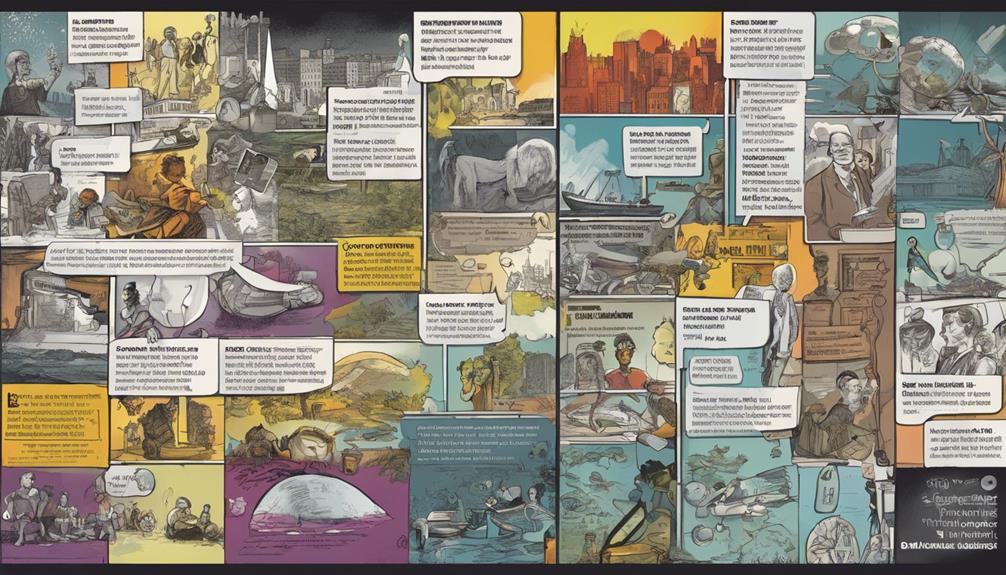
The evolution of design thinking has reshaped problem-solving methodologies across diverse sectors, leaving a lasting impact on innovation practices. Here's how this evolution has influenced the world:
- Design Thinking Emergence: Design thinking methodology emerged in the 1990s, gaining popularity in tech, business, and social-impact sectors.
- Key Players' Influence: Key entities like IDEO and Stanford's d.school notably contributed to evangelizing design thinking and its human-centered design approach.
- Sector Expansion: The influence of design thinking extended beyond its origins, impacting sectors such as healthcare, government, tech, and education.
- Empowering Designers: Design thinking broadened the definition of design, empowering designers to reinvent systems and tackle complex problems effectively.
The impact of design thinking's evolution is evident in the way it has revolutionized problem-solving approaches, encouraging innovation and fostering creative solutions to address societal challenges.
Positive Deviance Solutions

Positive Deviance Solutions leverage local expertise to creatively address intricate social challenges, aligning with the innovative problem-solving approach of Design Thinking.
By tapping into the wisdom and knowledge already present within communities, Positive Deviance Solutions aim to address systemic issues effectively. Design thinking principles encourage the prototyping of solutions that emerge from this local expertise, enabling a more targeted and impactful response to social problems.
The Positive Deviance Initiative serves as a platform to showcase successful solutions developed within communities using design thinking methodologies.
Despite the potential benefits, some organizations may face challenges in adopting Positive Deviance Solutions due to a fear of failure. However, by embracing a broader approach and fostering collaboration, these solutions aim to drive systemic change and create lasting positive impacts on society.
In essence, Positive Deviance Solutions offer a pathway for leveraging local insights, fostering creative problem-solving, and ultimately contributing to transformative social change through the application of design thinking principles.
Impact Assessment and Collaboration

Utilize impact evaluation techniques and cooperative strategies to enhance the effectiveness of design thinking initiatives for social innovation. When it comes to design thinking for social impact, incorporating impact evaluation and collaboration is essential for driving meaningful change. Here are four key points to keep in mind:
- Continuous Assessment: Impact evaluation in design thinking involves ongoing evaluation and feedback loops to guarantee projects are on track and making a difference in society.
- Interdisciplinary Teams: Collaboration within design thinking thrives when diverse teams with varied expertise come together to brainstorm, ideate, and implement solutions for social challenges.
- Metrics for Decision-Making: Utilize a mix of quantitative and qualitative metrics to measure the impact of initiatives, guiding future decision-making and strategy development.
- Successful Cooperation: Openness, curiosity, and a willingness to experiment are essential elements that drive successful collaboration within the design thinking process, leading to tangible positive changes in communities.
Frequently Asked Questions
How Design Thinking Can Be Used for Social Change?
You can use design thinking for social change by identifying issues, understanding needs, brainstorming solutions, and testing them. Collaboration and empathy are essential for scaling impactful solutions and driving positive societal change.
How Does Design Thinking Solve Social Problems?
Design thinking solves social problems by identifying pressing issues, understanding user needs deeply, and brainstorming innovative solutions. It involves prototyping and testing solutions for effectiveness and scalability, fostering collaboration and partnerships for lasting impact.
Why Is Design Thinking Important in Today's World?
Design thinking is important in today's world because it helps you understand complex issues by focusing on human needs. It fosters innovation, encourages collaboration, and drives positive change, leading to more effective solutions that empower diverse communities.
What Is the Power of Designing for Social Impact?
Designing for social impact empowers you to create sustainable solutions for complex social challenges. By focusing on people's needs and fostering collaboration, creativity, and empathy, you drive positive change and build more inclusive communities.
Conclusion
Now that you've seen how design thinking for social impact is changing the world, it's clear that this approach is like a compass guiding us towards a better future.
By combining creativity, empathy, and innovation, we can tackle complex social issues and create positive change.
So, let's continue to embrace the power of design thinking and work together to build a more sustainable and equitable world for all.
Let's be the architects of change!





